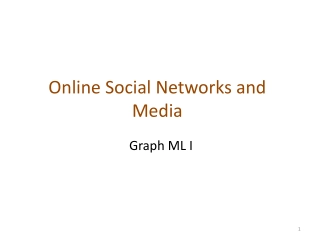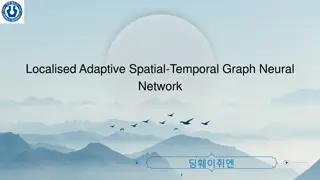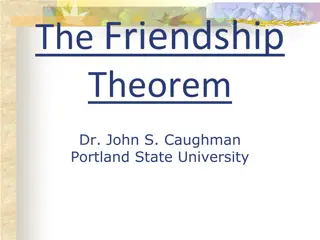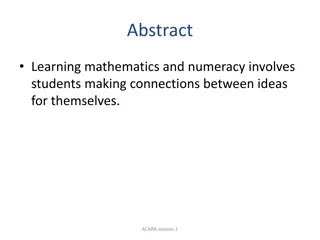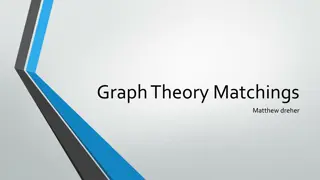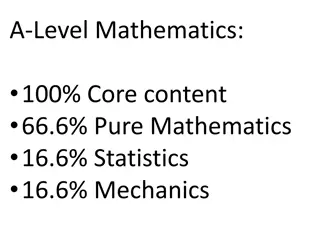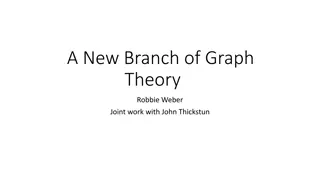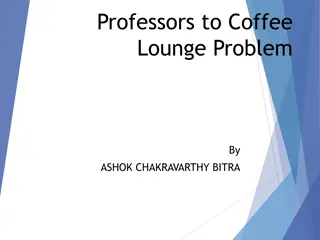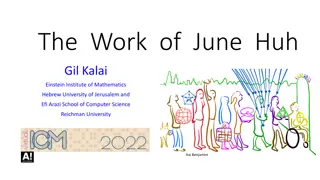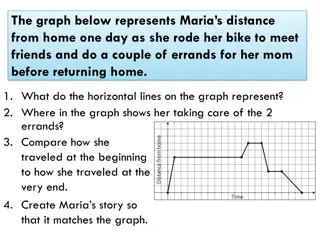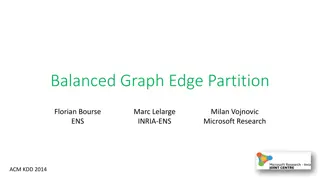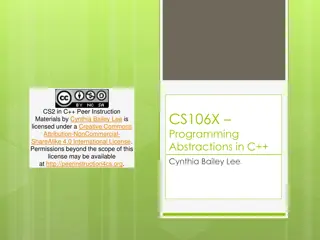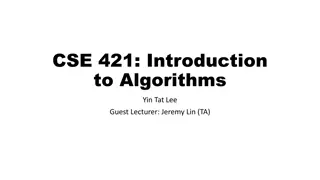Graph Theory in Mathematics Curriculum
Integrate graphs and networks into math curriculum to engage students with practical applications. Explore simple graphs, directed graphs, bipartite graphs, matching problems, and planar graphs across different year levels. Enhance understanding of concepts like complete graphs, vertices, edges, and more.
Download Presentation

Please find below an Image/Link to download the presentation.
The content on the website is provided AS IS for your information and personal use only. It may not be sold, licensed, or shared on other websites without obtaining consent from the author.If you encounter any issues during the download, it is possible that the publisher has removed the file from their server.
You are allowed to download the files provided on this website for personal or commercial use, subject to the condition that they are used lawfully. All files are the property of their respective owners.
The content on the website is provided AS IS for your information and personal use only. It may not be sold, licensed, or shared on other websites without obtaining consent from the author.
E N D
Presentation Transcript
Dot to Dot and Beyond Graphs and Networks Graph Theory rob_money22@yahoo.com.au jwidmer@scitech.net.au
The Space Curriculum What to ditch? move? Graphs and networks are now in VCAA Maths v2.0 Year 10 and in VCE General Maths and Specialist Maths. Is graphs and networks curriculum appropriate to earlier year levels? Do we still need congruence axioms, angles on parallels, angles in a circle? What content best meets student needs and interests?
Year 6+ Simple Graphs Complete Graphs have no multiple edges have all possible edges Five people are playing in a chess tournament. What matches have yet to be played? The complete graph on n vertices has n(n 1)/2 edges. Who can claim to be the best player? Everyone! What other simple graphs would interest students?
Year 7+ Directed Graphs Each edge has a direction What is at the bottom of this food chain? What does each directed edge mean? Other directed graphs:- older than, closer to school than from other studies e.g. science
Year 7+ Bipartite Graphs From Source vertices to Sink vertices Draw in 8 edges to represent the following. Alby and Bet have visited all 3 states. Charlie has visited NSW and SA. Dannie has visited NSW and QLD. Evie has visited just QLD. What other bipartite graphs might students make? e.g students vs sports that they play.
Year 8? Bipartite Graphs Matching Problems Can you remove edges until each candidate is matched with just one of the jobs? Why was this originally called the marriage problem? What else could the candidates and jobs represent? e.g. positions players can take. books that students can talk about.
Year 8+ Planar Graphs no overlapping edges The complete graph of 6 edges on 4 vertices can be drawn without the edges overlapping. K4 is planar. Can you draw all 10 edges on 5 vertices without edges overlapping? No. K5 is non-planar. So is any graph containing K5.
Year 8+ Which Graph is Planar? Isomorphic graphs Both! They are the same graph . u - / x p These graphs are isomorphic and planar. For no intersections redraw pn. With one extra edge (vz or mr) we would have the complete bipartite graph K3,3, which is non planar. G is planar iff neither K3,3 nor K5 is a subgraph, subdivision or minor of G. v m y q w n z - r.
Year 8+: Eulers Rule and Map Colouring for planar graphs Which part of the diagram represents the sixth face of the cube? How many vertices, edges and faces? To prove V + F = E + 2 by mathematical induction start with 1 + 1 = 0 + 2. How many colours are needed here if adjacent faces need different colours?
Year 9: Walks, Cycles, Trails & Paths A walk is a sequence of edges that are either adjacent or identical, e.g. ABA (length 2) and ABCAB (length 4). A cycle is a closed walk( last vertex = 1st) e.g. ABCDA A trailhasno repeated edgese.g. ABCADE Semi Eulerian trail (all edges, once each) e.g. CBAEDACD If edge CD was not there the graph would have the Eulerian trail ACBAEDA (also last vertex = 1st) . A pathhas no repeated verticese.g. ABCD Semi Hamiltonian path (all vertices, once each) e.g. ABCDE Hamiltonian path (also last vertex = 1st) e.g. ABCDEA
Year 9: Hamiltonian Graphs a cycle using each vertex just once Knight s Tour problems were the first Hamiltonian problems studied Rudrata in the 9th century. A simple graph on 3 or more vertices is Hamiltonian if:- deg(v) n/2 for all vertices or if deg(v) + deg(w) n for all non-adjacent pairs The converses do NOT apply.
Eulerian Trails a cycle using each edge just once An Eulerian trail exists in a graph with all vertices of even degree. How many extra edges are required to eulerise this graph of a tetrahedron? Is there an Eulerian trail on this graph of an octahedron?
Year 9: Circuits Around Networks Euler/Postie Trails and Hamilton Paths How many of the 22 blocks does a bus need to cover twice as it goes all around this network? How many blocks does the complete bus route take? How many blocks for a garbage truck that needs to cover both sides of every road? How many Hamilton circuits are there? (visiting each of the 16 vertices just once)
Circuits Around Networks Solution These six blocks need to be covered twice. The other 16 blocks can be covered by an Eulerian trail, so the bus route takes 6 x 2 + 16 = 28 blocks. The garbage truck must also cover 16 blocks in the reverse direction a total of 28 + 16 = 44 blocks. There are 3 Hamilton circuits here,each in clockwise or anti-clockwise directions.
Year 9+: Trees Trees contain no cycles Find the minimum spanning tree for this diagram showing travelling times between cities. A tree on 7 vertices has 6 edges. Choose the 6 shortest edges. Which one or two cities might be best as distribution centres?
A Local Area Network Tree Adapt for your home or school.
Year 10: Weighted Graphs The Postman and Travelling Salesman Problems Find the shortest distance for A to visit the other cities and return home. The postman can have repeat visits. The travelling salesman can t. . distances Home A B C D E F Home A 0 136 63 111 45 99 B 136 0 55 126 52 132 C 63 55 0 42 69 56 D 111 126 42 0 7 141 E 45 52 69 7 0 6 F 99 132 56 141 6 0
The Postman Problem Using the minimum spanning tree The graph shows the minimum spanning tree of length 152 plus the edge BC. Route AEFEDCBEA uses AE and EF twice and visits E three times. Its length is 258.
Travelling Salesman Solution There are 60 Hamilton circuits that could be tested. The minimum spanning tree to all vertices except E (214) plus the two shortest edges from E (13) gives 227, so the solution must be 227. The nearest neighbour routes have length 369 starting from D and 345 starting from E.
Year 10+ Adjacency and Incidence Matrices The 1,1 element in A2 is 2: 2 there and back walks. The 2,4 element in A3 is 4: 4 walks of length 3. The 1,4 element in A4 is 5: 5 walks of length 4. The matrix product Angives how many walks of length n there are from vertex i to vertex j
Year 10+: Weighted Directed Graphs Shortest Path to D = 8 + 5 + 7 = 20 Longest path to D = 8 + 26 = 34 Critical Path: 29 + 4 + 13 = 46. Slack time at D = (46-7) 34 = 5 Maximum flow: minimum cut = 8 + 7 + 4 = 19
Year 10+ Allocation We want one job for each worker at minimum overall cost. There are 24 possible allocations here.
Year 10+ Allocation By the Hungarian Algorithm
Year 10+ Allocation . By the Hungarian Algorithm Now solve by inspection or go on. 6 is the minimum uncovered entry.
Year 10+ Allocation By the Hungarian Algorithm
Summary for Discussion How much before Year 10? As presented here:- Maths v2.0 Level 10:- Simple and Complete Graphs Year 6+? Directed Graphs Year 7+? Bipartite Graphs Year 7+? Planar Graphs Year 8+? Euler s Rule for Planar Graphs Year 8+? Euler and Hamilton Circuits Year 9+? Trees Year 9+? Weighted Graphs Year 10? Weighted Directed Graphs Year 10+? Interpret networks and network diagrams used to represent relationships in practical situations - and describe connectedness. VCE:- All of this and more:- Proof in Specialist Maths.
Elaborations in Maths 2.0 recognising what real-world quantity(elements and connections) is represented by the vertices and the edges of a graph investigating the use of graphs to represent a network, such as for the (Eulerian trail) K nigsberg problem investigating how polyhedrons may be represented as a (planar)network: Euler s formula F + V = E + 2 investigating (tree?) diagrams for social networks, intranet, LAN, electrical wiring, wireless network of a home and practical problems involving connections, power overload or the need for routers investigating the use of networks to represent authentic situations, for example travel; food webs; metabolic networks, chemical or biological structures and kinship systems
Some Teaching Resources COMAP USA - Consortium for Maths and its Applications Mathigon - USA Math Insight UK NRich UK Plus Maths UK The Wilson pdf UK, for teachers https://www.maths.ed.ac.uk/papers/wilsongraph.pdf
The Space Curriculum What to ditch? add? move? Student needs and interests? Graphs and networks but at which Year levels prior to VCE? Congruence axioms? Angles on parallels? Angles in a circle? Euclidean proof? Refs: John s website for this powerpoint and our emails for further discussion Rob s articles in Vinculum 1/2024 and 2/2024 rob_money22@yahoo.com.au jwidmer@scitech.net.au
Direct Proof Start with the given information and proceed by logical steps to the result required. 1. A regular graph of degree r on n vertices has nr edges. Proof: Use the Handshaking lemma to justify the 2. There are n(n-1) edges on a complete graph. Proof: Each edge is joined to n 1 other edges. 3. There are 2 n(n-1) labelled graphs on n vertices. Proof: Each of the n(n-1) edges is either there or not there.
Proof by Mathematical Induction Euler s Rule In a plane drawing of a connected planar graph V+ F = E + 2 Proof: Start with one vertex, for which 1 + 1 = 0 + 2. If the degree of each vertex of a connected graph is even, then the graph is Eulerian. Adding an edge requires the addition of either one more vertex or one more face. The complete graph on n vertices has n(n 1) edges. Every tree with n vertices has n 1 edges. A simple graph on 2n vertices containing no triangles has at most n2edges.
Proof by Contradiction In any graph the number of vertices of odd degree is even. Proof: If the number was odd then the sum of all vertex degrees would be odd, which contradicts the handshaking algorithm. If G is a simple graph with greater than n = 2 vertices, and if deg(v) + deg(w) n for each pair of non-adjacent vertices v and w, then G is Hamiltonian. . Every simple planar graph contains a vertex of degree at most 5. The K3,3 and K5 graphs are non-planar.
Alkanes C4H10 In the isomers of propane each carbon atom has degree 4 n -butane and 2-methyl propane both have the formula C4H10 Crum-Brown 1864 Polya 1930 There are 2 trees with 4 vertices.
Electrical Circuits Kirchoff 1845 Four cycle equations for: VWZYXV, VWZV, VWZYVand WZYW e.g. For VWZV, i1R1+ i2R2= E For VYZV, i2R2+ i6R6+ i5R5= 0 Five vertex equations e.g. For vertex V, i1+ i5= i2+ i3
Bipartite Planar Graphs Can you add the four remaining edges without overlapping? Can you add the five remaining edges without overlapping? Can you install electricity, gas and water to a house without pipes overlapping? No. The K3,3 graph is non planar Yes. The K5,2 graph is planar
Regular Graphs All vertices have the same degree Petersen graph - degree d = 3, V = 10 vertices and E = 15 edges. Also the regular polyhedra:- Cube degree 3, V = 8 and E = 12 Tetrahedron degree 3, V = 4 and E = 6 Dodecahedron degree 3, V = 20, E = 30 Octahedron degree 4, V = 6, E = 12 Icosahedron degree 5, V = 12, E = 30 V + F = E + 2 and V = 2E/d. Use these equations to prove that there are just 5 regular polyhedra.
Chromatic Number Scheduling Jobs The chromatic number of a graph is the smallest number of colours needed to colour the vertices so that no two adjacent vertices share the same colour. Vertices of the same colour could represent jobs that can be scheduled simultaneously.
A Balanced Graph 21 edges, 9 of which are positive. 6 positive edges join 4 people (or groups) who all get on together. 3 positive edges join 3 people (or groups) who all get on together. If one of these 3 edges turned negative we would have an unbalanced graph an eternal triangle of 3 people (or groups) who cannot get on together.
A code for every labelled tree There are 2(n -2) labelled trees Remove the lowest end vertex (2) and start the sequence with the label of the adjacent vertex (6) Repeat: Remove the lowest remaining end label (3), so the sequence becomes 65. Repeat: Remove the lowest end label 4, so the sequence becomes 656. Repeat: Remove the lowest end label 5, so the sequence becomes 6565. Repeat: Remove 5, so the sequence becomes 65651.
A labelled tree for every code There are 2(n -2) labelled trees From sequence 65651 and vertices 1, 2, 3, 4, 5, 6, 7. The smallest number NOT in both lists is 2, so reduce both lists and Join vertices 6 and 2. Repeat: Join vertices 5 and 3 Repeat: Join vertices 6 and 4 Repeat: Join vertices 5 and 6 Repeat: Join vertices 1 and 45 Join the remaining vertices 1 and 7
Hamiltons Icosian Game Every one of the 20 vertices of the icosahedron has degree 3. Hamilton s Icosian Game of 1857 was a puzzle to find a path through all 20 vertices without repetition.
Connectedness Undirected Graphs are either connected or disconnected. Connected Directed Graphs are either:- weakly connected i.e. connected with direction disregarded. or semi connected - a directed path in one or other direction between every pair of vertices or strongly connected directed paths between all pairs of vertices


